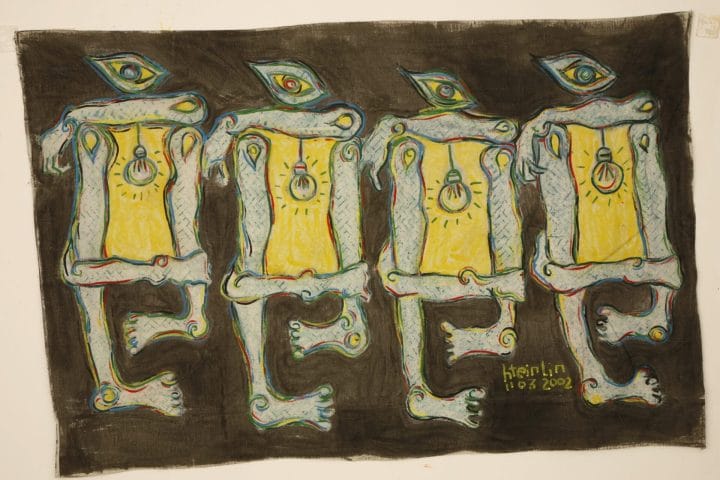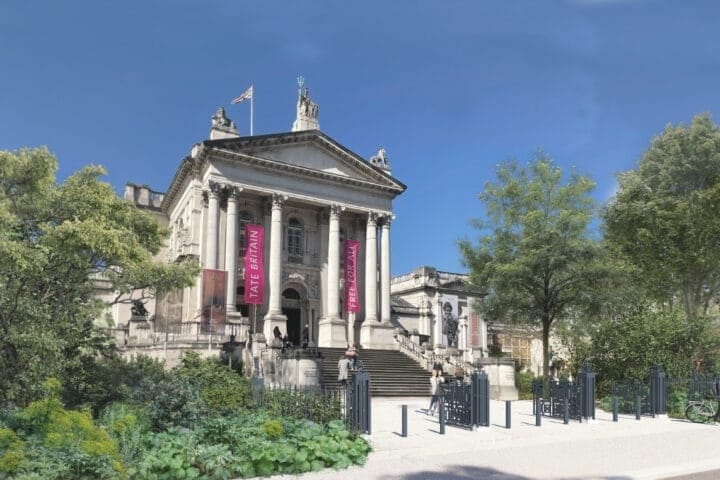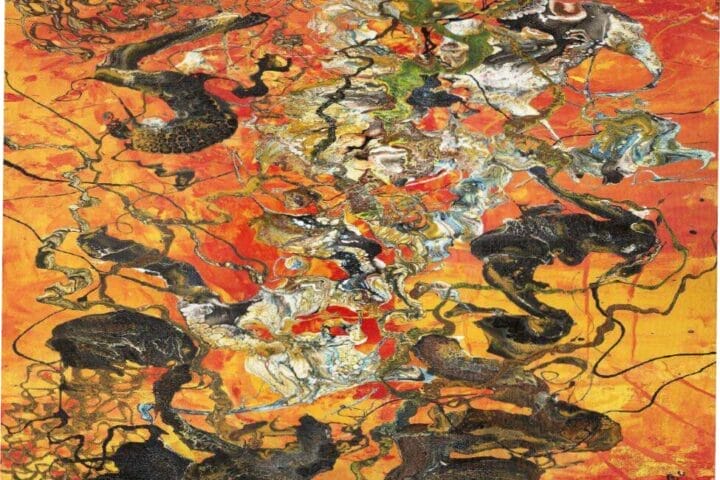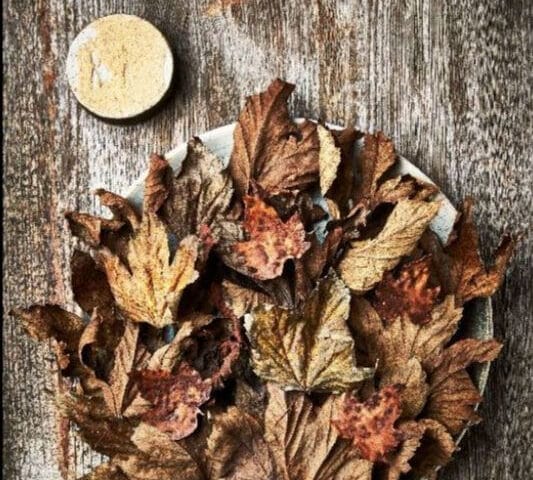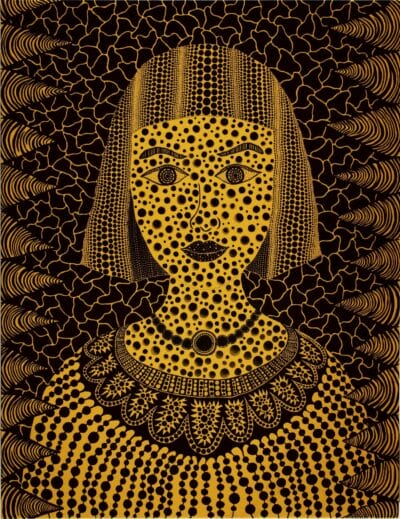
The Guggenheim Museum Bilbao presents Yayoi Kusama: 1945 to Now, an ambitious retrospective dedicated to one of the most influential figures of contemporary art and a cultural icon of the 21st century. The exhibition, sponsored by Iberdrola, will immerse the visitor in the obsessive, singular, avant-garde universe of Yayoi Kusama (b. 1929, Japan) that has evolved and unfolded over the seven decades of her extraordinary artistic career.
From the first drawings she made as a teenager during World War II to her most recent immersive works, this retrospective gathers a selection of 200 paintings, sculptures, performances, moving images, largescale installations, and archive materials.
Organized chronologically and thematically, Kusama’s creative production is grouped around the great themes and questions which have guided her creative explorations throughout her life: Infinity, Accumulation, Radical Connectivity, Biocosmic, Death, and Force of Life. The works are moreover situated in the various political and social contexts she has lived through.
TOUR OF THE EXHIBITION
Self-Portrait
Kusama’s work rests on self-affirmation and self-referentiality, and the exhibition therefore includes a space which is devoted to self-portraits, an important genre in her practice throughout her entire career, which introduces the artist and the exhibition.
The itinerary begins with Self-Portrait (1950), a dark painting with a pink flesh-colored sunflower floating over a human mouth, and continues through the surreal collages of the 1970s, an etching of the 1990s, and the colorful acrylic canvases of the 21st century. It ends with Portrait (2015), a composition in the form of a collage that combines the artist’s signature polka dot pattern with nets and tentacle-like forms, also recurrent motifs.
Infinity
Kusama’s first solo show in New York, held at the Brata Gallery in 1959, contained five enormous paintings entitled Infinity Nets, which were composed of a minuscule pattern of looping arcs painted in white all over a black ground. This practice was a novelty for the New York art public, although it also found a special resonance in European avant-garde circles. Untitled (Off Cut of Infinity Net Painting) (1960) is a fragment of the 10-metre-long Infinity Net painting she created for the first solo exhibition at Stephen Radich Gallery in New York in 1961.
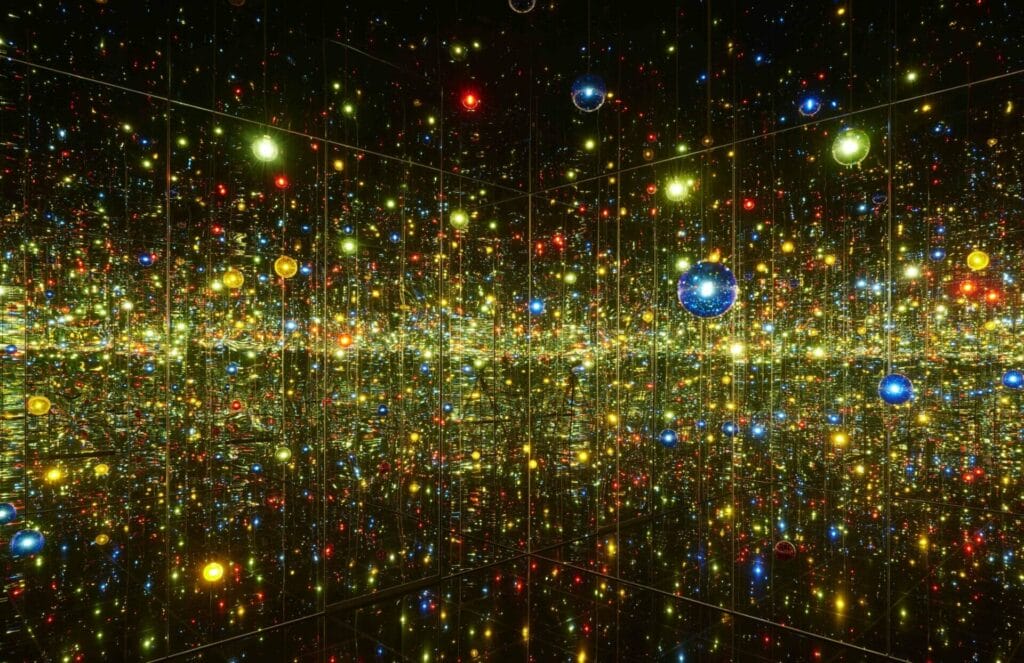
These works, first inspired—as in the case of The Sea (1959)—by what she saw during her flight across the Pacific Ocean in 1957 from Japan to the United States, explore infinity through nets and dots suggesting galactic dimensions, with polka dots representing stars, planets, and the earth itself as “one polka-dot among a million stars.”
The duality of infinity and nothingness is integral to Kusama’s characteristic pattern of nets and polka dots, which she conceives as reciprocal parts: the negative spaces within the net are found the polka dots, and vice versa. The Infinity Nets of the 1990s and 2000s strike up relationships with the natural forces that inspire the artist, resembling rolling cloud-forms or star fields without end.
In the meantime, Transmigration (2011), with its four panels of vibrant colors, makes reference to Kusama’s vision of a continuous cycle of life through the rebirth of nature and the ocean, as in her early net paintings.
Accumulation
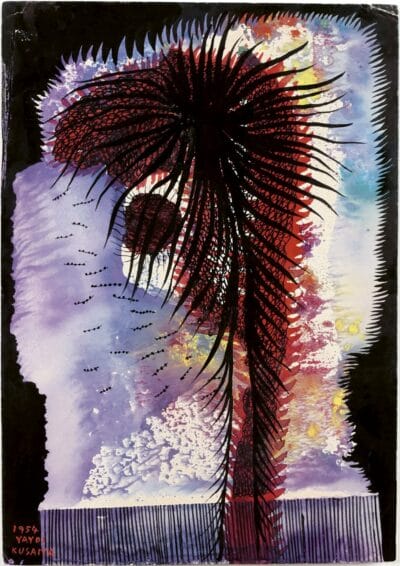
The idea of accumulation in Kusama’s art is more than an obsessive tendency. It may be understood as a logical expansion of her creative vision, equally applicable to an array of drawings on her studio floor or to a global body of artwork.
The collage Accumulation of Letters (1961) is one of the earliest accumulation works of the artist, made using cut-out pieces of the artist’s own name from the printed invitations to an exhibition.
Within a year, this impulse overflowed into three dimensions, with the artist covering ordinary household objects and furniture, clothing, shoes, luggage, and other items in hundreds of stuffed-fabric growths. This results in mysterious objects, such as Untitled (Chair) (1963), with complex organic, erotic, and uncanny associations. However, besides being incredibly laborious, this method was not enough to manifest her growing vision.
Little by little, the compulsive desire to multiply these soft forms led Kusama to expand her vision through her infinity mirror rooms in beginning in 1965, and into silver or patterned fabrics in the 1970s and 1980s such as Accumulation of Hands (1980), where a sofa and chairs are enwrapped by hundreds of silver gloves.
Radical Connectivity
In the late 1960s, Kusama developed a dematerialized artistic practice centered on public engagement and performance. As an immigrant to the United States, she ultimately adopted a position of non-conformity and even overt provocation, advocating gay rights, denouncing racial and gendered discrimination, parodying and critiquing American politics, and protesting the Vietnam War through her installation and multimedia work.
Mainly due to the frequent public nudity in these performances, they were widely covered in the mainstream press, where they were characterized variously as counterculture demonstrations and tasteless publicity stunts. Today, we can see that this approach is at the heart of a broader artistic strategy that might be called ‘radical connectivity’, which encompasses Kusama’s lifelong embrace of the mass media.
Her work from this period ranged across fashion design, audiovisual light shows, political protest, installations, and expanded cinema. At the core of all these activities were her body-painting performances, in which performers stripped naked and were covered by the artist with polka dots in an act of what she called ‘self-obliteration’, a concept which represents liberation through destruction of the ego, and also liberation of the individual from the constraints of society, including prevalent female role models. An example is the installation Self-Obliteration (1966–74), which consists of everyday objects painted over with bright colors, including six mannequins, chairs, and a dining table.
Kusama’s practice turned inwards in the following decade, but self-obliteration resurfaced as a subject that became prominent in her words from 1975 onwards.
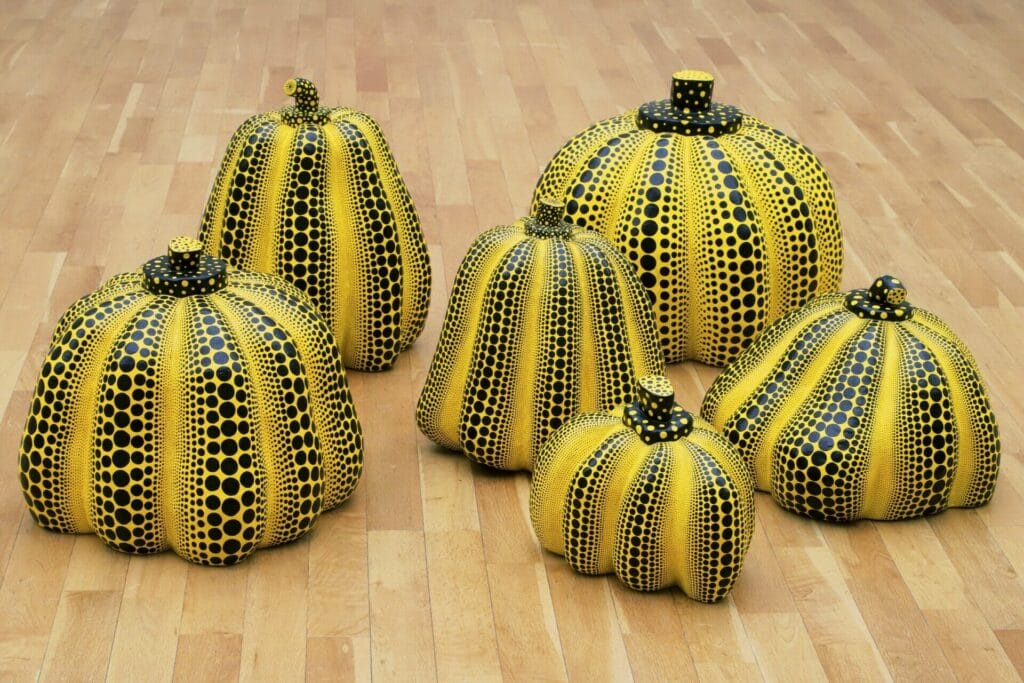
Biocosmic
From an early age, growing up on her family’s plant nursery, Yayoi Kusama had a deep connection with organic life. Besides the visual connection of these ‘infinite’ plantations with her tendency towards repetition, the artist observed plant anatomies, as well as their cycles of life and decay, as in Untitled (Flower Sketches) (ca. 1945), taken from her wartime sketchbook.
Her use of jute seed bag rather than canvas for such works as The Bud (1951) reflects Kusama’s resourcefulness at a time when canvas was in short supply and conveys the power of nature via both materials and content.
The term ‘biocosmic’ or ‘cosmic nature’ is intended to illustrate the artist’s boundless concept of the ‘cosmos’ and her particular notion of organic life. It provides a kind of lens through which Kusama’s whole philosophy and artistic production might be viewed.
When Kusama first explained her polka dots in the late 1960s, comparing them to celestial bodies or cosmic symbols, she was seeking to connect heaven and earth, or the macroscopic and the microscopic, in order to “lay bare the mystery” of life itself. However, Kusama’s engagement with cosmic nature is not entirely mystical but also intimate and literal. This is exemplified by pumpkins, which appear in her visual lexicon in the early 1980s and offer an immediate identification with nature. The pumpkins attest to the animism—or belief in ‘spirit’ as a force common to every living thing—of the artist, who identifies them as a kind of benevolent plant spirit as well as a reflection of her own soul.
Another example of Kusama’s attitude to nature is found in her biomorphic sculptures and paintings of the 1980s and 1990s, such as the writhing serpentine forms in Sex Obsession (1992), which evoke roots and tentacles that oscillate between alienation from the world and an expansive sense of becoming one with the cosmos.
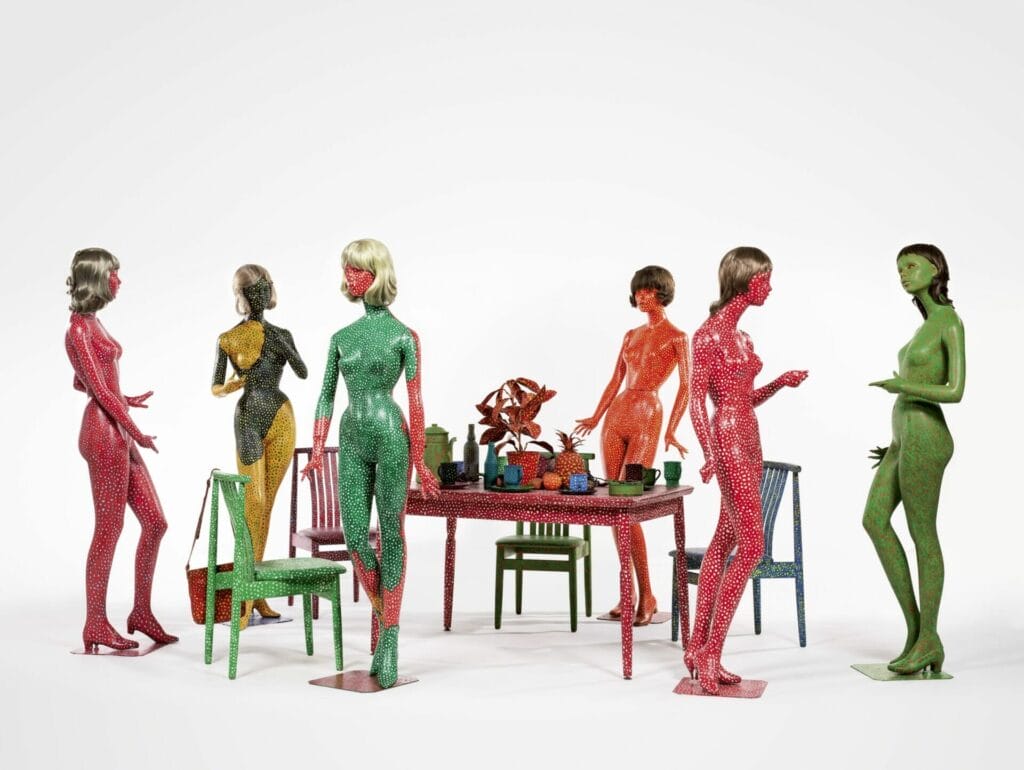
Death
Possibly influenced by a childhood surrounded by ephemeral vegetable life, and doubtlessly marked by her experiences of the war and post-war period during her adolescence, Kusama’s work constantly addresses the threshold between life and death, a theme already present in her earliest sketches and paintings of flowers. An example of this is her painting Dead Leaves of Corn (1945).
In the mid-1970s, Kusama was forced to reckon with the deaths of two important people in her life: her father, Kamon, with whom she had shared a complicated relationship, and Joseph Cornell, the American artist who had been Kusama’s closest friend in New York. Kusama has said that her depression and desire for death were deep at this time.
The stuffed soft sculptures Kusama created during this time, such as Death of a Nerve (1976), constitute her own symbols of life and death. Kusama expresses the view that death is not the end point but another phase in life which can give rise to a new form, in line with the Eastern belief of reincarnation.
Force of Life
Around 1988, a shift occurred in the art and psyche of Kusama. She was working as diligently as ever from her Tokyo studio, but her career was finally gaining momentum. Exhibition opportunities had steadily grown over the preceding decade, and her published novels had received praise in avant-garde literary circles.
Since that year, the key themes of her work have been the force of life and the healing power of art. She sees her artistic role as transmuting suffering on behalf of others as well as herself, declaring in 1999: “I create art for the healing of all mankind.” Her work in the new millennium seeks to amplify this message.
In 2009, as she was turning eighty years old Kusama embarked on the largest series ever in her career, My Eternal Soul. Continuing until 2021, the series encompasses more than 900 joyful and colorful paintings that are striking for their novel palettes and motifs as well as their uniformly square format, which had almost never appeared before. In the last couple of years during the COVID-19 pandemic, due to and despite various constraints she faced, Kusama continued to paint but in smaller scales, calling this new series Everyday I Pray for Love. This latest body of work continues her unabashed lifelong declaration of her work celebrating love and life while at the same time confronting the darkness of death and even thoughts of suicide, as she has through many years. In light of the devastation the whole humanity faced during the pandemic, Kusama’s latest paintings gain even more powerful resonances.
Art has always been a matter of survival for Kusama, but now, it also sustains her life: “O time. Hold still awhile. I have so much more work to do. There are so many things I want to express.”
In conjunction with this exhibition, the Museum exhibits Infinity Mirrored Room – A Wish for Human Happiness Calling from Beyond the Universe (2020). In this mirrored installations, Kusama’s continuous obsession with the effect of depth and infinity creates luminous structures with effects that reminds us of the impossible, the magical and the galactic, difficult to find anywhere else. In this installation, only shown previously in Yayoi Kusama’s Museum in Japan, the artist transforms her unsettling hallucinations into mystical visions, just like immersing in the stardust of the infinite universe.
DIDAKTIKA
As part of the Didaktika project, the Museum designs educational spaces and organizes complementary activities for the exhibitions, both in the galleries and online, to contribute to the appreciation and understanding of the works on display.
For Yayoi Kusama: 1945 to Now, the Didaktika is displayed as its online version, Did you know that? within the website’s section, presenting a chronology of Yayoi Kusama’s well-established career.
Activities
Opening Talk (June 22)
Conversation among the exhibition curators Doryun Chong, Mika Yoshitake, and Lucía Agirre presenting the exhibition.
Shared Reflections*
Professionals of the Guggenheim Museum Bilbao offer different perspectives on and interpretations of each new exhibition:
– Curatorial Vision (July 12): Lucía Agirre, Museum and exhibition Curator
– Key Concepts (July 19): Luz Maguregui Urquiza, Education and Interpretation Coordinator
*Sponsored by Fundación Vizcaína Aguirre
Grow your Own Pumpkin (Daily activity in July and August)
Pumpkins are one of Kusama’s recurring motifs, a symbol of happiness and her fascination with nature. Pumpkin seeds in a container will be handed out to the youngest Museum visitors. Once home, they will be able to water the seed directly on the container, which will eventually sprout, and then they will be able to transplant it to a pot; all this will encourage children to care for the plant until a pumpkin (similar to Kusama’s) fully develops.
This activity will be free of charge with Museum admission, daily in July and August, while stock lasts.
Film screening Kusama-Infinity (September 26)
Screening of the documentary Kusama-Infinity, directed by Heather Lenz. Released in 2018, the film explores Kusama’s fierce determination to become a world-renowned artist.
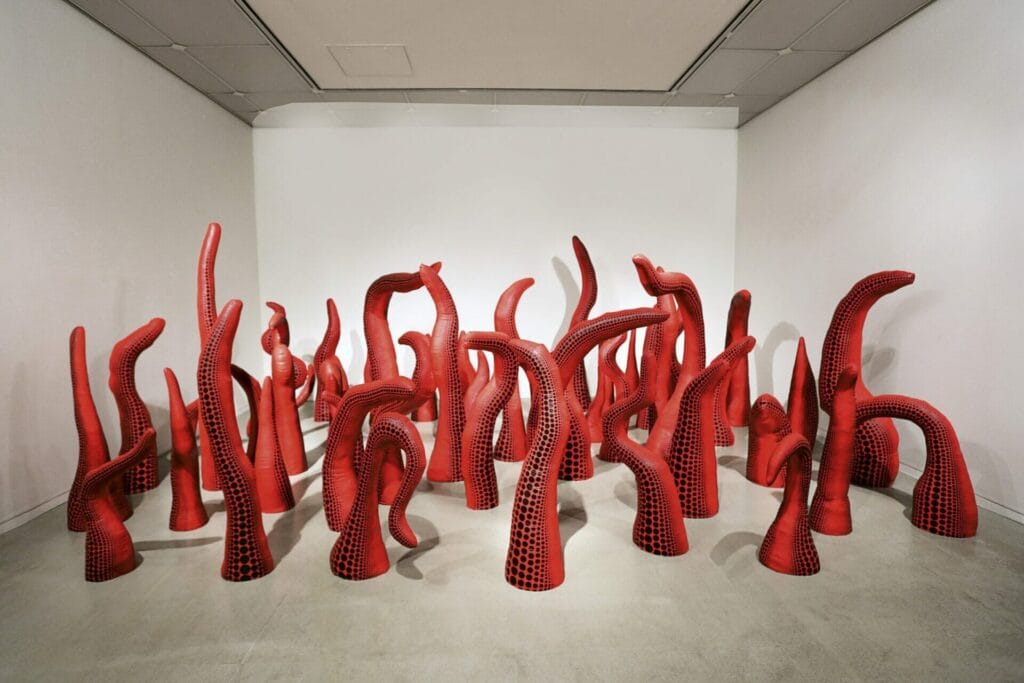
CATALOGUE
The catalogue accompanying the exhibition contains a broad selection of works by Kusama, together with essays by specialists Mika Yoshitake, Doryun Chong, and Isabella Tam which shed light on the principal themes and questions running through the artist’s production. The volume also includes an extensive chronology in which the artist’s long creative career is paralleled by the events of the various periods she has lived through.
- Dates: June 27 to October 8, 2023
- Curators: Doryun Chong and Mika Yoshitake, in collaboration with Lucía Agirre
- Sponsored by Iberdrola
- Exhibition organized by M+, Hong Kong, in collaboration with the Guggenheim Museum Bilbao
Guggenheim Museum Bilbao
Abandoibarra Etorb., 2, 48009 Bilbo, Bizkaia


